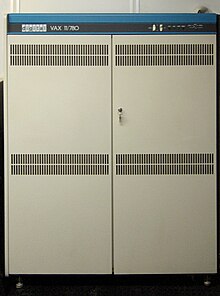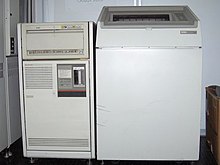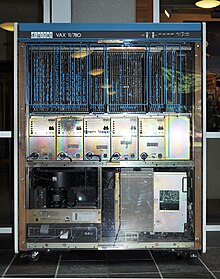What Is Register Value 0x80000000
 | |
| Designer | Digital Equipment Corporation |
|---|---|
| Bits | 32-bit |
| Introduced | 1977 (1977) |
| Design | CISC |
| Type | Register-Register Register-Memory Memory-Retentiveness |
| Encoding | Variable (1 to 56 bytes) |
| Branching | Condition code |
| Endianness | Trivial |
| Page size | 512 bytes |
| Extensions | PDP-11 compatibility mode, VAX Vector Extensions,[1] VAX VM extensions |
| Open | No |
| Registers | |
| General purpose | 16 × 32-bit |
| Floating point | non nowadays, uses the GPR |
| Vector | xvi × 4096-chip (512 bytes) |
VAX is a series of computers featuring a 32-scrap instruction set architecture (ISA) and virtual memory that was developed and sold past Digital Equipment Corporation (Dec) in the belatedly 20th century. The VAX-11/780, introduced Oct 25, 1977, was the first of a range of popular and influential computers implementing the VAX ISA. The VAX family unit was a huge success for DEC - over 100 models were introduced over the lifetime of the blueprint,[ citation needed ] with the final members arriving in the early 1990s. The VAX was succeeded past the DEC Alpha, which included several features from VAX machines to make porting from the VAX easier.
VAX was designed as a successor to the xvi-bit PDP-xi, i of the most successful minicomputers in history with approximately 600,000 examples sold. The arrangement was designed to offer backward compatibility with the PDP-xi while extending the memory to a full 32-flake implementation and adding demand paged virtual retentivity. The name VAX refers to its Virtual Address eXtension concept that immune programs to brand use of this newly available memory while withal being uniform with unmodified user mode PDP-11 lawmaking. The name "VAX-11", used on early models, was chosen to highlight this capability. The VAX ISA is considered a complex instruction set computer (CISC) design.
Later models in the series dropped the -11 branding as PDP-11 compatibility was no longer a major concern. The line expanded to both high-end machines like the VAX 9000 also every bit to the workstation-scale systems like the VAXstation series. The VAX family unit ultimately contained ten distinct designs and over 100 individual models in total. All of these were compatible with each other and normally ran the VAX/VMS operating system.
VAX has been perceived as the quintessential CISC ISA,[2] with its very large number of associates language programmer-friendly addressing modes and automobile instructions, highly orthogonal instruction set architecture, and instructions for circuitous operations such as queue insertion or deletion, number formatting, and polynomial evaluation.[3]
Proper noun [edit]

The proper noun "VAX" originated as an acronym for Virtual Accost eXtension, both because the VAX was seen as a 32-flake extension of the older xvi-bit PDP-11 and considering it was (later Prime Figurer) an early adopter of virtual memory to manage this larger accost space.
Early versions of the VAX processor implement a "compatibility mode" that emulates many of the PDP-11's instructions, giving it the xi in VAX-11 to highlight this compatibility. Later versions offloaded the compatibility manner and some of the less used CISC instructions to emulation in the operating organization software.
Instruction ready [edit]
The VAX instruction set was designed to exist powerful and orthogonal.[4] When information technology was introduced, many programs were written in associates linguistic communication, so having a "programmer-friendly" educational activity set was of import.[5] [6] In time, as more than programs were written in high-level programming languages, the educational activity set became less visible, and the simply ones much concerned about information technology were compiler writers.
One unusual aspect of the VAX instruction ready is the presence of register masks[7] at the showtime of each subprogram.[4] These are arbitrary bit patterns that specify, when control is passed to the subprogram, which registers are to exist preserved. Since register masks are a form of data embedded within the executable lawmaking, they can make linear parsing of the machine code hard. This can complicate optimization techniques that are applied on machine code.[viii]
Operating systems [edit]

Stylized "VAX/VMS" used by Digital
The native VAX operating system is Digital'due south VAX/VMS (renamed to OpenVMS in 1991 or early 1992 when information technology was ported to Blastoff, modified to comply with POSIX standards, and branded as compliant with XPG4 by the X/Open consortium).[9]
The VAX architecture and OpenVMS operating system were "engineered meantime" to have maximum advantage of each other, as was the initial implementation of the VAXcluster facility. Other VAX operating systems have included diverse releases of Berkeley Software Distribution (BSD) UNIX up to 4.3BSD, Ultrix-32, VAXELN, and Xinu. More recently, NetBSD[10] and OpenBSD[11] have supported various VAX models and some piece of work has been done on porting Linux to the VAX architecture.[12] OpenBSD discontinued support for the architecture in September 2016.[xiii]
History [edit]

VAX 8350 front view with embrace removed
The first VAX model sold was the VAX-xi/780, which was introduced on October 25, 1977, at the Digital Equipment Corporation'south Annual Meeting of Shareholders.[xiv] Bill Strecker, C. Gordon Bell's doctoral pupil at Carnegie Mellon University, was responsible for the architecture.[15] Many unlike models with unlike prices, operation levels, and capacities were subsequently created. VAX superminicomputers were very popular in the early on 1980s.
For a while the VAX-eleven/780 was used as a standard in CPU benchmarks. It was initially described as a one-MIPS machine, because its performance was equivalent to an IBM Arrangement/360 that ran at one MIPS, and the Organization/360 implementations had previously been de facto operation standards. The bodily number of instructions executed in 1 second was well-nigh 500,000, which led to complaints of marketing exaggeration. The result was the definition of a "VAX MIPS," the speed of a VAX-11/780; a reckoner performing at 27 VAX MIPS would run the same programme roughly 27 times faster than the VAX-xi/780.
Within the Digital community the term VUP (VAX Unit of Performance) was the more common term, because MIPS exercise not compare well across different architectures. The related term cluster VUPs was informally used to depict the aggregate functioning of a VAXcluster. (The operation of the VAX-11/780 still serves as the baseline metric in the BRL-CAD Criterion, a performance analysis suite included in the BRL-CAD solid modeling software distribution.) The VAX-11/780 included a subordinate stand-alone LSI-11 computer that performed microcode load, booting, and diagnostic functions for the parent reckoner. This was dropped from subsequent VAX models. Enterprising VAX-11/780 users could therefore run three different Digital Equipment Corporation operating systems: VMS on the VAX processor (from the hard drives), and either RSX-11S or RT-11 on the LSI-11 (from the single density single bulldoze floppy deejay).
The VAX went through many different implementations. The original VAX 11/780 was implemented in TTL and filled a iv-by-five-foot chiffonier[xvi] with a single CPU. Through the 1980s, the high-end of the family unit was continually improved using always-faster discrete components, an development that concluded with the introduction of the VAX 9000 in Oct 1989. This blueprint proved as well complex and expensive and was ultimately abandoned non long afterwards introduction. CPU implementations that consisted of multiple emitter-coupled logic (ECL) gate array or macrocell array chips included the VAX 8600 and 8800 superminis and finally the VAX 9000 mainframe class machines. CPU implementations that consisted of multiple MOSFET custom chips included the 8100 and 8200 class machines. The VAX 11-730 and 725 low-end machines were congenital using AMD Am2901 bit-piece components for the ALU.
The MicroVAX I represented a major transition within the VAX family unit. At the time of its pattern, it was non yet possible to implement the full VAX compages as a single VLSI bit (or even a few VLSI chips as was later on done with the V-11 CPU of the VAX 8200/8300). Instead, the MicroVAX I was the showtime VAX implementation to move some of the more complex VAX instructions (such as the packed decimal and related opcodes) into emulation software. This division essentially reduced the amount of microcode required and was referred to as the "MicroVAX" architecture. In the MicroVAX I, the ALU and registers were implemented as a single gate-array chip while the rest of the machine command was conventional logic.
A total VLSI (microprocessor) implementation of the MicroVAX architecture arrived with the MicroVAX 2's 78032 (or DC333) CPU and 78132 (DC335) FPU. The 78032 was the beginning microprocessor with an on-board memory management unit[17] The MicroVAX Ii was based on a single, quad-sized processor board which carried the processor chips and ran the MicroVMS or Ultrix-32 operating systems. The car featured 1 MB of on-lath memory and a Q22-bus interface with DMA transfers. The MicroVAX Two was succeeded by many further MicroVAX models with much improved performance and retentivity.
Further VLSI VAX processors followed in the course of the V-11, CVAX, CVAX SOC ("Organisation On Chip", a single-flake CVAX), Rigel, Mariah and NVAX implementations. The VAX microprocessors extended the compages to inexpensive workstations and later also supplanted the loftier-end VAX models. This broad range of platforms (mainframe to workstation) using 1 architecture was unique in the figurer industry at that fourth dimension. Sundry graphics were etched onto the CVAX microprocessor dice. The phrase CVAX... when yous care enough to steal the very best was etched in broken Russian every bit a play on a Authentication Cards slogan, intended as a message to Soviet engineers who were known to exist both purloining DEC computers for military applications and contrary technology their chip design.[eighteen] [xix] Past the belatedly 1980s, the VAX microprocessors had grown in ability to exist competitive with discrete designs. This led to the abandonment of the 9000 and its replacement by NVAX-powered models, with the ultimate versions every bit the VAX 7000/10000 of 1992.
In Dec's production offerings, the VAX architecture was eventually superseded by RISC applied science. In 1989 DEC introduced a range of workstations and servers that ran Ultrix, the DECstation and DECsystem respectively, based on processors that implemented the MIPS architecture. In 1992 Dec introduced their ain RISC instruction set up architecture, the Alpha AXP (later renamed Blastoff), and their ain Alpha-based microprocessor, the DECchip 21064, a high performance 64-bit pattern capable of running OpenVMS.
In August 2000, Compaq announced that the remaining VAX models would exist discontinued by the finish of the year,[20] but sometime systems remain in widespread utilize.[21] The Stromasys CHARON-VAX and SIMH software-based VAX emulators remain available. VMS is now managed past VMS Software Incorporated, admitting but for the Alpha, HPE Integrity, and x86-64 platforms.
Processor architecture [edit]

MicroVAX 3600 (left) with printer (right)
| DEC VAX registers | ||||||||||||||||||||||||||||||||||||||||||||||||||||||||||||||||||||||||||||||||||||||||||||||||||||||||||||||||||||||||||||||||||||||||||||||||||||||||||||||||||||||||||||||||||||||||||||||||||||||||||||||||||||||||||||||||||||||||||||||||||||||||||||||||||||||||||||||||||||||||||||||||||||||||||||||||||||||||||||||||||||||||||||||||||||||||||||||||||||||||||||||||||||||||||||||||||||||||||||||||||||||||||||||||||||
| ||||||||||||||||||||||||||||||||||||||||||||||||||||||||||||||||||||||||||||||||||||||||||||||||||||||||||||||||||||||||||||||||||||||||||||||||||||||||||||||||||||||||||||||||||||||||||||||||||||||||||||||||||||||||||||||||||||||||||||||||||||||||||||||||||||||||||||||||||||||||||||||||||||||||||||||||||||||||||||||||||||||||||||||||||||||||||||||||||||||||||||||||||||||||||||||||||||||||||||||||||||||||||||||||||||
Virtual memory map [edit]
The VAX virtual memory is divided into four sections. Each is one gigabyte (in the context of addressing, 2xxx bytes) in size:
| Section | Address Range |
|---|---|
| P0 | 0x00000000 - 0x3fffffff |
| P1 | 0x40000000 - 0x7fffffff |
| S0 | 0x80000000 - 0xbfffffff |
| S1 | 0xc0000000 - 0xffffffff |
For VMS, P0 was used for user process space, P1 for procedure stack, S0 for the operating system, and S1 was reserved.
Privilege modes [edit]
The VAX has iv hardware implemented privilege modes:
| No. | Mode | VMS use | Notes |
|---|---|---|---|
| 0 | Kernel | OS kernel | Highest privilege level |
| ane | Executive | File system | |
| 2 | Supervisor | Crush (DCL) | |
| 3 | User | Normal programs | Everyman privilege level |
Processor condition register [edit]
The Process Condition Register has 32 bits:
| CM | TP | MBZ | FD | IS | cmod | pmod | MBZ | IPL | MBZ | DV | FU | 4 | T | N | Z | V | C |
|---|---|---|---|---|---|---|---|---|---|---|---|---|---|---|---|---|---|
| 31 | 30 | 29 | 27 | 26 | 25 | 23 | 21 | 20 | 15 | 7 | 6 | 5 | 4 | 3 | two | one | 0 |
| Bits | Meaning |
|---|---|
| 31 | PDP-11 compatibility mode |
| 30 | trace pending |
| 29:28 | MBZ (must be aught) |
| 27 | first part done (interrupted educational activity) |
| 26 | interrupt stack |
| 25:24 | electric current privilege manner |
| 23:22 | previous privilege mode |
| 21 | MBZ (must be null) |
| 20:sixteen | IPL (interrupt priority level) |
| 15:viii | MBZ (must be zero) |
| 7 | decimal overflow trap enable |
| 6 | floating-bespeak underflow trap enable |
| 5 | integer overflow trap enable |
| 4 | trace |
| 3 | negative |
| two | goose egg |
| 1 | overflow |
| 0 | carry |

The SPEC-1 VAX, a VAX eleven/780 used for benchmarking, showing internals
VAX-based systems [edit]
The starting time VAX-based system was the VAX-11/780, a member of the VAX-11 family. The high-end VAX 8600 replaced the VAX-11/780 in Oct 1984 and was joined by the entry-level MicroVAX minicomputers and the VAXstation workstations in the mid-1980s. The MicroVAX was superseded past the VAX 4000, the VAX 8000 was superseded by the VAX 6000 in the late 1980s and the mainframe-class VAX 9000 was introduced. In the early 1990s, the fault-tolerant VAXft was introduced, equally were the Alpha compatible VAX 7000/10000. A variant of various VAX-based systems were sold as the VAXserver.
SImultaneous Machine ACceSs (SIMACS) [edit]
Arrangement Industries developed an ability to give more than 1 Dec CPU, just not at the same time, write access to a shared disk. They implemented an enhancement named SImultaneous Machine ACceSs (SIMACS),[22] [23] which allowed their special deejay controller to prepare a semaphore flag for disk access, allowing multiple WRITES to the same files; the disk is shared by multiple December systems. SIMACS also existed on PDP-11 RSTS systems.
Canceled systems [edit]
Canceled systems include the BVAX, a high-cease emitter-coupled logic (ECL) based VAX, and two other ECL-based VAX models: Argonaut and Raven.[24] Raven was canceled in 1990.[25] A VAX named Gemini was also canceled, which was a autumn-dorsum in case the LSI-based Scorpio failed. It never shipped.
Clones [edit]
A number of VAX clones, both authorized and unauthorized, were produced. Examples include:
- Systime Computers Ltd of the U.k. produced clones of early VAX models such as the Systime 8750 (equivalent to the VAX 11/750).[26]
- Norden Systems produced the ruggedized, Armed services-specification MIL VAX series.[9]
- The Hungarian Central Enquiry Institute for Physics (KFKI) produced a series of clones of early on VAX models, the TPA-xi/540, 560 and 580.[27]
- The SM 52/12[28] from Czechoslovakia, adult at VUVT Žilina (today Slovakia) and produced from 1986 at ZVT Banská Bystrica (today Slovakia).
- The East German VEB Robotron Yard 1840 (SM 1710) is a clone of the VAX-11/780 and Robotron M 1820 (SM 1720) is a re-create of the MicroVAX II.
- The SM-1700 is a Soviet clone of the VAX-11/730, SM-1702 was a clone of MicroVAX 2 and SM-1705 was a clone of VAX-11/785.[29] These systems ran a diverseness of clone operating systems - DEMOS (based on BSD Unix), MOS VP (based on VAX/VMS) or MOS VP RV (based on VAXELN).[xxx]
- The NCI-2780 Super-mini, also sold as Taiji-2780, is a clone of the VAX-11/780 developed by Due north China Plant of Computing Technology in Beijing.[31] [32]
Further reading [edit]
- Coy, Peter (January 6, 2021). "Who Remembers the VAX Minicomputer, Icon of the 1980s?". Bloomberg News . Retrieved Jan 9, 2021.
References [edit]
- ^ "VAX MACRO and Teaching Fix Reference Manual". OpenVMS documentation. Apr 2001.
- ^ Bistriceanu, Virgil. "Figurer Compages - Grade notes" (PDF). Illinois Institute of Engineering science. Retrieved April fifteen, 2022.
- ^ Payne, Mary; Bhandarkar, Dileep (1980). "VAX floating point: a solid foundation for numerical computation". SIGARCH Figurer Architecture News. ACM. 8 (4): 22–33. doi:10.1145/641845.641849. ISSN 0163-5964. S2CID 15021135.
- ^ a b Levy, Henry; Eckhouse, Richard (June 28, 2014). Calculator Programming and Architecture: The Vax. Digital Press. ISBN9781483299372.
- ^ "Another Approach to Pedagogy Ready Architecture—VAX" (PDF).
... instruction set architectures, we chose the VAX as programmer-friendly teaching set, an asset
- ^ "VAX".
Esp. noted for its large, assembler-programmer-friendly instruction set --- an asset that
- ^ "VAX MACRO and Instruction Set up Reference Manual". www.itec.suny.edu . Retrieved June 19, 2016.
- ^ Goss, Clinton F. (August 2013) [Outset published June 1986]. Motorcar Lawmaking Optimization: Improving Executable Object Code (PDF) (PhD). Vol. Computer Science Department Technical Report #246. Courant Establish, New York University. arXiv:1308.4815. Bibcode:2013arXiv1308.4815G. Retrieved August 22, 2013.
- Clinton F. Goss (2013) [1986]. Machine Code Optimization - Improving Executable Object Code (PhD thesis). Courant Institute, New York University.
- ^ a b Rainville, Jim; Howard, Karen, eds. (1997). "VAX/VMS at 20". Digital Equipment Corporation. Retrieved July twenty, 2018.
- ^ "NetBSD/vax".
- ^ "OpenBSD/vax".
- ^ "Porting Linux to the VAX".
- ^ "OpenBSD 6.0". 2016. Retrieved June xx, 2017.
- ^ "VAX 11/780, The First VAX System (October 1977)".
- ^ Slater, Robert (1987). Portraits in Silicon. MIT Printing. p. 213. ISBN978-0-262-69131-iv.
- ^ "VAX 11/780 Computer: CPU". Computer History Museum. Retrieved October 24, 2012.
- ^ The Computer History Simulation Project: MicroVAX 2 (1985)
- ^ micro.magnet.fsu.edu, Steal the best, retrieved January 30, 2008. The Russian phrase was: СВАКС... Когда вы забатите довольно воровать настоящий лучший
- ^ The Figurer History Simulation Project: CVAX (1987), retrieved January 30, 2008
- ^ "VAX Systems: A letter from Jesse Lipcon". Archived from the original on August fifteen, 2000.
- ^ "If It Ain't Broke, Don't Gear up It: Ancient Computers in Apply Today". PCWorld . Retrieved October eleven, 2021.
- ^ Wand, R.; Kesteven, G.; Rayner, P. (February 24, 1984). "Computing Requirements for AT Software Evolution" (PDF).
- ^ Joshi, Prem; Delacroix, Jacques (September 1984). "New Flexibility For Multiple VAX/VMS". HARDCOPY. pp. 64–68.
- ^ Mark Smotherman (July 19, 2008). "Who are the Computer Architects?". Retrieved September 30, 2008.
- ^ Supnik, Bob (2007). "Raven". Retrieved March 1, 2019.
- ^ "RAL Computer science Report 1984-85". Retrieved Oct 15, 2007.
- ^ "The TPA story". Retrieved October 15, 2007.
- ^ Dujnic, J.; Fristacky, Northward.; Molnar, L.; Plander, I.; Rovan, B. (1999). "On the history of information science, computer engineering, and figurer applied science development in Slovakia". IEEE Annals of the History of Computing. 21 (iii): 38–48. doi:10.1109/85.778981.
- ^ Laimutis Telksnys; Antanas Zilinskas (July 1999). "Computers in Lithuania" (PDF). IEEE Annals of the History of Computing. 21 (3): 31–37. doi:10.1109/85.778980. S2CID 16240778.
- ^ Prokhorov North.L.; Gorskiy 5.E. "Basic software for 32-bit SM computer models". Software Systems Periodical (in Russian). 1988 (3). Retrieved September 15, 2021.
- ^ U.South. Congress, Office of Applied science Cess (July 1987). Technology transfer to China. U.Southward. Authorities Printing Office. p. 96. ISBN9781428922914. OTA-USC-340.
- ^ Xia Nanyin; Chan Laixing (1990). "Satellite Launch and TT&C Systems of Red china and Their Roles in International Cooperation". In F. Sharokhi; J. South. Greenberg; T. Al-Saud (eds.). Infinite Commercialization: Launch Vehicles and Programs. American Institute of Aeronautics and Astronautics. p. 244. ISBN0-930403-75-4.
External links [edit]
| | Wikimedia Commons has media related to VAX. |
- HP: VAX Systems
- December Microprocessors
- SimH VAX Open source emulator that supports VAX architecture
- The complete Digital Technical Journals
What Is Register Value 0x80000000,
Source: https://en.wikipedia.org/wiki/VAX
Posted by: chiltonowayll.blogspot.com


0 Response to "What Is Register Value 0x80000000"
Post a Comment